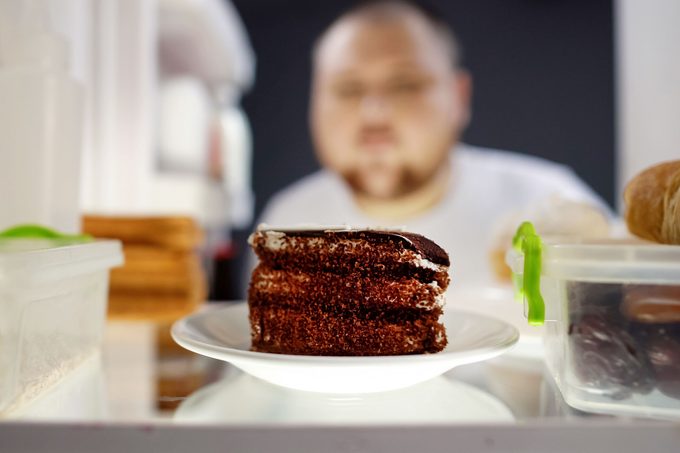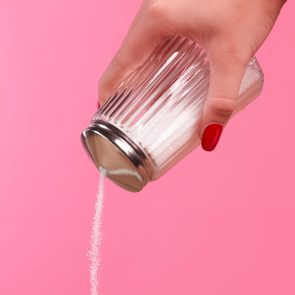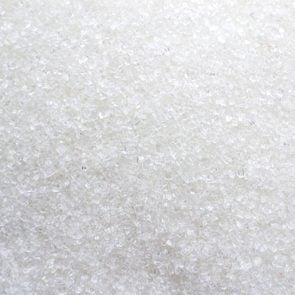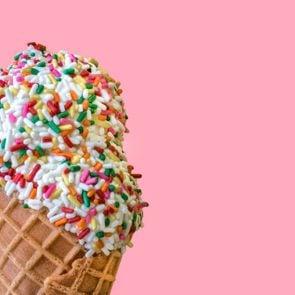Trying to Quit Sugar? A Diabetes Patient Reveals the One Change That Saved His Life
Updated: Apr. 13, 2022
The American Diabetes Association has estimated that nearly 50 million Americans are diabetic or pre-diabetic. After diabetes took his mother's life, one man's diagnosis forced him to seek a dietitian's support—a choice that led to a life-changing (and possibly life-saving) shift in perspective.

By Mike Madigan, as told to Charlotte Hilton Andersen
I had a wicked sweet tooth. Not a day went by that I didn’t eat something sugary, usually after something salty. My days revolved around this pattern: eat a high-salt meal—usually a fast food combo—and then follow it up with dessert. No meal felt complete without sweets. My favorites were doughnuts, ice cream, or a lime Arctic Freeze from Dairy Queen. Between meals, I’d drink soda after soda.
When I was a kid, we were too poor to afford a lot of junk food. But, my mom loved to treat us on the occasion she could—and candy, chips, and fast food were one way she showed her love. She meant well…but in effect, this turned sweets into “forbidden fruit.” When I started to make my own money, I saw junk food as the pinnacle of reward. In my mind, eating junk anytime I craved it was proof of how far I’d come in life.
By the time I moved out, I had a full-blown sugar addiction. I figured my sweet tooth was just a part of me and there was nothing I could do about it.
Struggle with cravings? Nutrition Pros Just Revealed What 12 Common Food Cravings Secretly Suggest about Your Health
I thought I could exercise away a bad diet
In high school and college I’d been an athlete, competing in the hammer throw and shot put. My coaches gave us some basic information on nutrition, but those were the days of pasta “carb loads” before meets and refueling with Gatorade and other added-sugar drinks. I figured I could counteract all that because I was working out so much—sometimes hours every day—so it didn’t really matter what I ate. That’s what I thought.
In 2009, I began to show signs of overtraining syndrome. I began sweating excessively during warm-ups, my resting heart rate was high, I had insomnia, and I couldn’t recover even after short workouts. My doctor prescribed total rest. I stopped training, but I didn’t change my eating habits. “I’ll be back in the gym soon enough,” I told myself. Except I never returned.
Then, in 2012—after several years of dialysis treatments that had helped manage her own chronic diabetes symptoms—my mother underwent a long-awaited kidney transplant. Sadly, her body didn’t handle the surgery or the anti-rejection medications well. So my mom, who was one of the people I loved best in the world, died of complications from uncontrolled diabetes after the disease had damaged her kidneys.
I was devastated, as well as terrified of getting diabetes myself…just not enough to change my own diet.
My diabetes wake-up call
In 2018, when I was 46 years old, I saw my doctor for a routine checkup and lab work. According to the National Library of Medicine, a normal A1C level is four to five percent. Anything above 5.7 percent is considered pre-diabetic, and above 6.5 percent is diabetic. My blood test showed an A1C of nine percent.
As far as blood sugar? A normal level is under 140 milligrams per deciliter. My blood sugar was nearly 300.
I had full-blown diabetes, and the scariest part was that I’d experienced zero symptoms. Without that blood test, I wouldn’t have known how sick I was. That scared me more than anything. Now I was terrified of going blind, having to go on dialysis, and dying too young, like my mom.
I resolved to change. That would start with eliminating processed sweets and lowering the amount of sugar in my diet by a drastic amount.
Craving Sugar? A Dietitian Says You May Need More of This Surprising Nutrient
The best change I made to quit sugar
My doctor suggested I enroll in a diabetes management class run by a registered dietitian. Signing up turned out to be the single best thing for changing my lifestyle and diet to conquer my intense sugar cravings. The dietitian taught me about how all carbs count as sugars, and how insulin works in my body to drive cravings. She also taught me to make healthy swaps in my diet. For instance, I still love sweet drinks. But these days, instead of soda, I fill a 64-ounce bottle with ice and water and then add one eight-ounce can of pineapple juice. I also discovered that eating a container of unsweetened applesauce takes the edge off of a sugar craving.
But, even more, that class was a support group. I didn’t feel so scared and alone, and I became really close to the other people in my cohort. I saw diabetes as a death sentence, and having that support helped me realize that it didn’t have to be. I can’t even explain how helpful it was to me to have others who really understood what I was going through. Those classes were worth every penny.
How I trained myself out of a sweet tooth and control my sugar cravings
I started getting a little bit of exercise each day, which helped, but getting my sugar intake under control was priority number one. My dietitian taught me that I don’t have to be perfect; that moderation is key—but that due to my disease, my concept of moderation has to be lower than other people’s concepts.
In addition to completing a diabetes education class, here’s what else has really helped me overcome sugar cravings:
- Plan my treats. No more mindless snacking on cookies just because I can. If I’m going to have a dessert, I will choose something I really want. Then, instead of eating it mindlessly, I sit down and enjoy it.
- Make it an actual treat. “Treat” implies that it’s something that happens rarely, but dessert isn’t a treat if you eat it after every single meal.
- Positive self-talk. It’s a little embarrassing, but sometimes when I walk past the bakery in the grocery store, I give myself a little pep talk. I also tell the doughnuts I will not be buying them—not even one.
- Stay hydrated. Some of my cravings were from being dehydrated. When I thought I was craving a sugary slushy, what my body really wanted was a glass of ice cold water.
- Circumvent temptations. I choose to simply avoid driving by certain restaurants. When a Dairy Queen commercial comes on, I either change the channel or turn off the TV to get up and move my body.
- Start my day with a success. Successes build on each other so every day, I give myself an “easy win.” For me, that means that the first thing I do after waking up is to make my bed. Boom: my day has started with doable discipline.
- Stay away from social media. Comparing myself to others was painful and unrealistic. Plus, there’s a lot of bad information on social media about diet, nutrition, and fitness.
How conquering my sugar cravings changed my life
Unfortunately, by the time my diabetes was discovered, it had already caused me liver damage. This means now, it’s not something I will ever be able to “cure,” but I manage it really well. I have to take a daily medication for the rest of my life. Today, my blood work isn’t perfect, but it’s significantly better. My A1C is around six percent, and my blood sugar typically stays below 200.
But the changes to my entire life have been so positive. I’ve lost over 20 pounds, I’m no longer depressed, I have fewer cavities. I have more energy, and my skin looks so much better. (Read A Dermatologist and Dietitian Just Listed the 5 Worst Foods That Age Skin Faster.)
In addition, I no longer feel like a slave to sugar—I’m amazed that I hardly think about treats at all anymore. I don’t need food to regulate my emotions. Feeling in control of my body and my life feels like success. In fact, as strange as it may sound, diabetes has been a real blessing. I’m actually happier as a diabetic than I was living my old life!
Sign up for The Healthy newsletter to get healthy inspiration and answers. Follow us on Facebook and Instagram, and keep reading:
- Here’s How Much Protein You Really Need in a Day, with a Kidney Doctor’s Wisdom
- The Best Gear for Working Out in Small Spaces—From a Personal Trainer
- Had a Heart Attack? These Are the 7 Foods You Need Now, From a Cardiologist and Dietitian
- My Blood Sugar and Cholesterol Led to a Heart Attack at 43. Here’s What Saved My Life





















